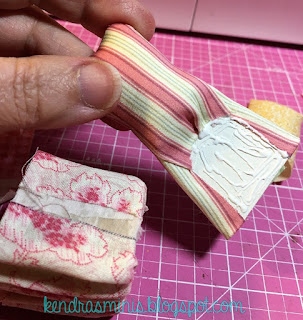Here is part 2 of the Slipper Chair tutorial. Seat back with faux pleat and seat cushion.
Supplies for Part 2:
- Sewing machine, matching thread
- Fray-Check (sewing seam sealer)
- Shirt cardboard, index card
- Small blob of polyester fiberfill (or fluff from an old pillow)
- VERY FINE glue applicator filled with craft glue (I used Sobo in my applicator)
- Pattern sheet (link here)
- For the seat back slip cover, cut the two pattern pieces “C” and “B” from fabric. (note that in photos my piece “C” is not straight across the bottom because I was using a scrap piece).
- Down the center back of the chair is a faux pleat. To make this, “draw” down the centerline of the back piece (wrong side of fabric) with a THIN line of glue. Make it wide enough so that when you cut on it, it will be sealed on both sides of the cut. The glue line is hard to see in the photo. Don’t cut this yet.
- Using a sewing machine and very small stitches (I used a stitch length of 2mm long), sew the back to the front RIGHT SIDES TOGETHER on the seam line (see photo).
- Put a line of “Fray Check” seam sealant all around the raw edges on both sides. Don’t let the solution spread past the line of sewing.
- Clip into the center of the heart where marked on the pattern but be sure NOT to clip through the stitching line. Trim the seam to about 1/8 inch.
- Turn inside out. Cut a piece of shirt cardboard to pattern “A”. Slip the cardboard piece “A” up into the back and make sure it fits. Remove cardboard piece and set aside (link to pattern - see supplies).
- If the glue on center back cut line is dry, cut on the line almost to the top (about ¼ inch from the top seam).
- Cut a “gusset” or faux pleat of a contrasting fabric using pattern piece “D”. Glue the gusset inside the split. Before it was dry I pinched the split together a little near the top, so it would look like it was bulging (and bows added later were holding it together).
- Place cardboard “A” piece up into the slipcover. Stuff the FRONT of the seat (side opposite of the gusset) with a little fiberfill.
- Glue down the open seams below the sewing line as needed to keep the sides together. You can see where this needs to be done when you have the cardboard inserted.
- Glue the back cover to the cardboard down both sides, covering the cardboard. Glue the raw edge of the cover against the cardboard just to seal in the stuffing (it should just touch the base when the back is glued on).
- Trim off any extending gusset. Fold up a ‘hem’ on the bottom edge of the slip cover and the gusset. I allowed mine to extend slightly past the bottom of the chair to look sort of like a train.
- Glue the back against the base covering the raw edges of the ruffled fabric skirt on the base.
- Cushion – (sorry I didn’t take many photos of these steps). Cut pattern piece “E” out of shirt cardboard or index card. Trim to fit your seat (a tiny bit smaller). Glue a small blob (size of a grape?) of stuffing to the middle of this cardboard seat. Cut fabric about ½ inch larger than seat on all sides. Fabric was wrapped over the stuffing and glued to the bottom of the cardboard. To do a neat job on rounded corners, first glue down the center of each side. Then when that is dry enough to handle, clip little tabs of fabric at the corners to try to minimize thick folds. Glue down the tabs on all corners neatly as possible, smoothing out any wrinkles. After covering with fabric, I ‘tufted’ two small dents using a needle and thread tying it at the bottom of the cardboard.
- Glue seat in place. Finished!
- To decorate the back, I tied three bows using my BittyBow bowmaker (you can buy it from the link at the right side of my blog!).
































